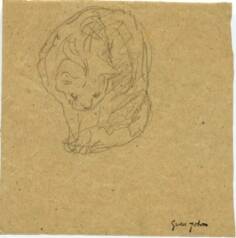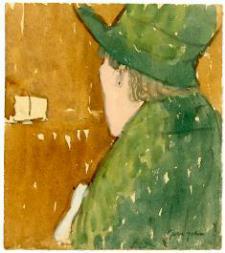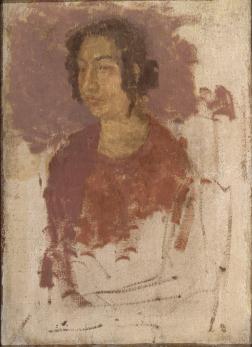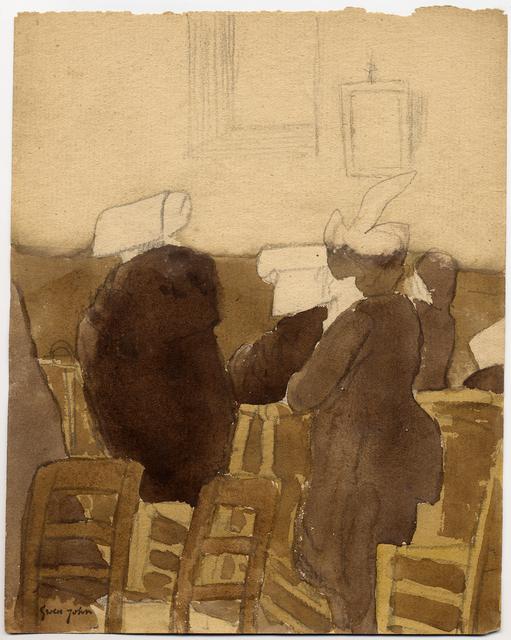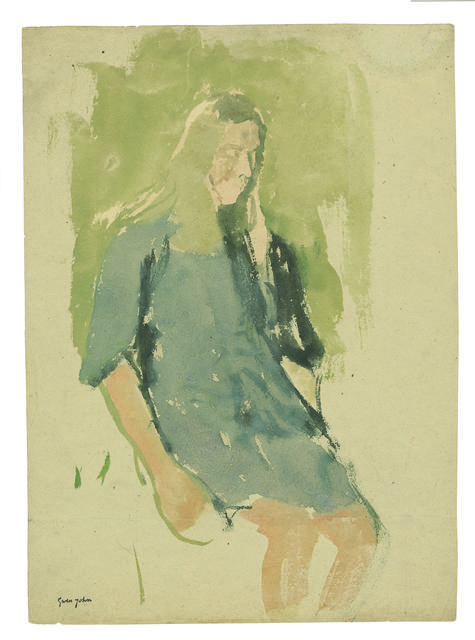Gwen John is now acknowledged to be one of the preeminent British artists of the 20th century. Since her own lifetime, her work has been deeply admired and seriously collected in Britain and America, and she is represented in numerous public collections in both places. Among those museums are the Tate Gallery, London; the National Museum of Wales, Cardiff; the City of Manchester Art Galleries; the Metropolitan Museum of Art, New York; The Museum of Modern Art, New York; the British Art Center, Yale University, New Haven, Connecticut; and the National Gallery of Art, Washington, D.C.
Cleveland Museum of Art, OH; Smith College Museum of Art, Northampton, MA; Yale Art Gallery, New Haven, CT
Born in 1876 and raised in Wales, in 1895 Gwen John joined her brother Augustus at the Slade School in London, where she studied with Henry Tonks and Frederick Brown in 1898. She then spent some months in Paris at the Académie Carmen, where James McNeill Whistler taught, before returning to London and a "subterranean life." In 1904, she went back to France where she was to remain until her death 35 years later.
During her first years in Paris, she established an independent, comparatively solitary existence, living in a series of modest Montparnasse rooms, painting, and supporting herself by working as an artist's model. She soon met Auguste Rodin for whom she posed and with whom she fell in love. Her self-effacing exterior masked a passionate nature, and Gwen John obsessively focussed that passion upon Rodin for nearly a decade.
GWEN JOHN (1876 - 1939)
In the early 1910s several significant changes occurred. Gwen John moved to the Paris suburb of Meudon, where Rodin lived, and where she was to stay for the rest of her life; she met John Quinn, the distinguished American collector, who became her patron; and she entered the Catholic Church, where she found considerable solace, particularly as her relationship with Rodin waned. This time, until Quinn's death in 1924, was that of her greatest artistic productivity, surely in large part because of Quinn's encouragement and support. She exhibited regularly at the Paris salons and was included in the historic 1913 Armory Show.
Quinn's death broke her strongest connection to the art world, and in her later years she became increasingly isolated. She maintained several old friendships, and formed one final passionate attachment, to Véra Oumançoff, sister-in-law of Jacques Maritain. This unreciprocated attachment was ended by Oumançoff in about 1930.
Gwen John's last decade was marked by growing self-neglect; a late visitor described her as living like a "feminine St Gerome." Her last painting was done in 1929; for several years longer she continued to work in gouache and watercolor, but there is no evidence that she did anything whatsoever after about 1933. In September 1939, having prepared her will leaving virtually everything to her nephew Edwin, Gwen John travelled to the sea, dying at Dieppe at the age of 63.
Gwen John must be seen as an Anglo-French artist. Although she consciously distanced herself from her background (declaring England "quite a foreign country"), her art always retained certain British characteristics. Its tonalism is a legacy of her Slade School training and New English Art Club associations; while the brushwork, surfaces, and palette of her mature paintings are reminiscent of her Camden Town contemporaries. However, she was by no means untouched by her French experience, and had a vivid appreciation of avant-garde Parisian art. In her later work, there are affinities with Picasso, Modigliani, Cézanne, Rouault, and Chagall, among others.
Her early paintings (among them several of her best known) are carefully executed genre subjects (for example, Portrait of Mrs Atkinson [Metropolitan Museum of Art, New York]; Interior with Figures [National Gallery of Victoria, Melbourne], for which no. 9 is a study; Girl Reading at the Window [Museum of Modern Art, New York], and A Corner of the Artist's Room in Paris [Sheffield City Art Galleries]).
By the end of the 1910s a singular characteristic of her art - her practice of repeating a composition with very little variation - had become evident. The remarkable series of the convalescent model dates from this time. Gwen John's often-expressed admiration of Cézanne is evident in these rigorously edited compositions: in the intentional areas of bare canvas and in the poses and proportions of the monumental figures. In the slightly later mulberry dress paintings, there is a resemblance to Modigliani's portraits; even the sitters' eccentric features (for which Modigliani was indebted to African sculpture) are strikingly alike.
Gwen John's early works on paper are meticulously executed in the Slade manner. The slightly later cat studies are notably spontaneous and fluid, reminiscent of Rodin's drawings. Her hundreds of watercolors of women and children in the Meudon church of the 1910s and 1920s have a kinship to the work of such French intimists as Bonnard and Vuillard. Her last watercolors and gouaches seem utterly French; they are opaque, brightly colored, abstracted images.
Gwen John wrote about herself with a characteristic combination of modesty and certainty: "I cannot imagine why my vision will have some value in the world - and yet I know it will...I think I will count because I am patient and recueillé."
CECILY LANGDALE
Back View of Three Nuns and Two Women in Church
Gouache and pencil on paper, 8 11/16 x 6 13/16
Stamped (at lower left): Gwen John [estate stamp]
Probably executed in the 1910s
Private collection
Cat Staring at Ground
Pencil on paper, 4 3/4 x 4 11/16 inches
Stamped (at lower right): Gwen John [estate stamp]
Probably executed about 1905-1908
GJ-3193
Rear View of Woman in Green Hat and Coat
Gouache on paper, 4 15/16 x 4 3/8 inches
Stamped (at lower right): Gwen John [estate stamp]
Probably executed during the late 1920s
GJ-1531
Woman in Mulberry Dress
Oil on canvas, 13 5/8 x 9 9/16 inches
Probably painted about 1923 - 1924
Private Collection
Cecily Langdale, principal of Davis & Langdale Company and author of Gwen John: with a Catalogue Raisonné of the Paintings and a Selection of the Drawings (Yale University Press, 1987), has written an essay for the rehanging of the Tenby Museum and Art Gallery's Gwen and Augustus John exhibition, in commemoration of Gwen John’s 140th birthday.
Girl with Long Hair in Blue Dress
Watercolor on paper, 12 1/2 x 9 1/4 inches
Stamped (at lower left): Gwen John [estate stamp]
Probably executed during the late 1910s
Ex coll. estate of the artist, until 2018
DLA-3174
DAVIS & LANGDALE COMPANY, INC.
NEW YORK, NY 10021
212-838-0333
